MARIANI’SVirtual Gourmet
September
14, 2014
NEWSLETTER
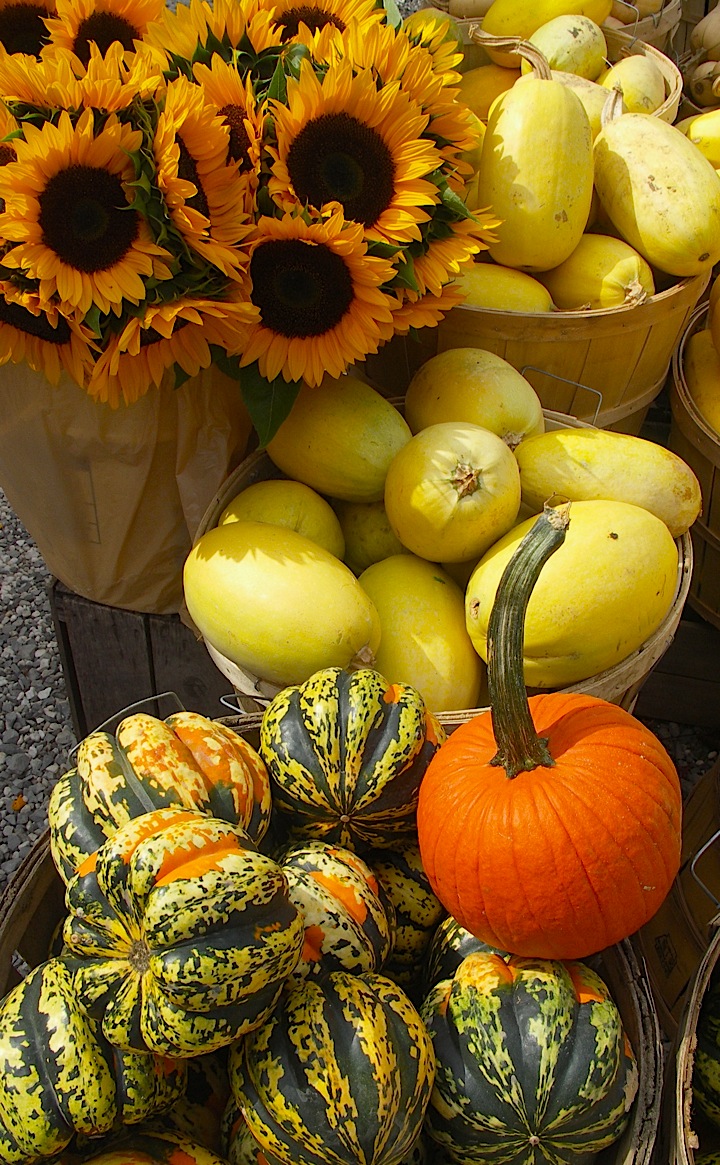
"Autumn
Squash, Upper Michigan" by Galina Dargery (2013)
IN THIS ISSUE
NEW ORLEANS, Part Two
By John Mariani
BARE NAKED TABLES
By John Mariani
NEW YORK CORNER
THE RED CAT
By John Mariani
NOTES FROM THE WINE CELLAR
The Wines of Veneto
By John Mariani
❖❖❖
NEW ORLEANS,
Part Two
By John Mariani
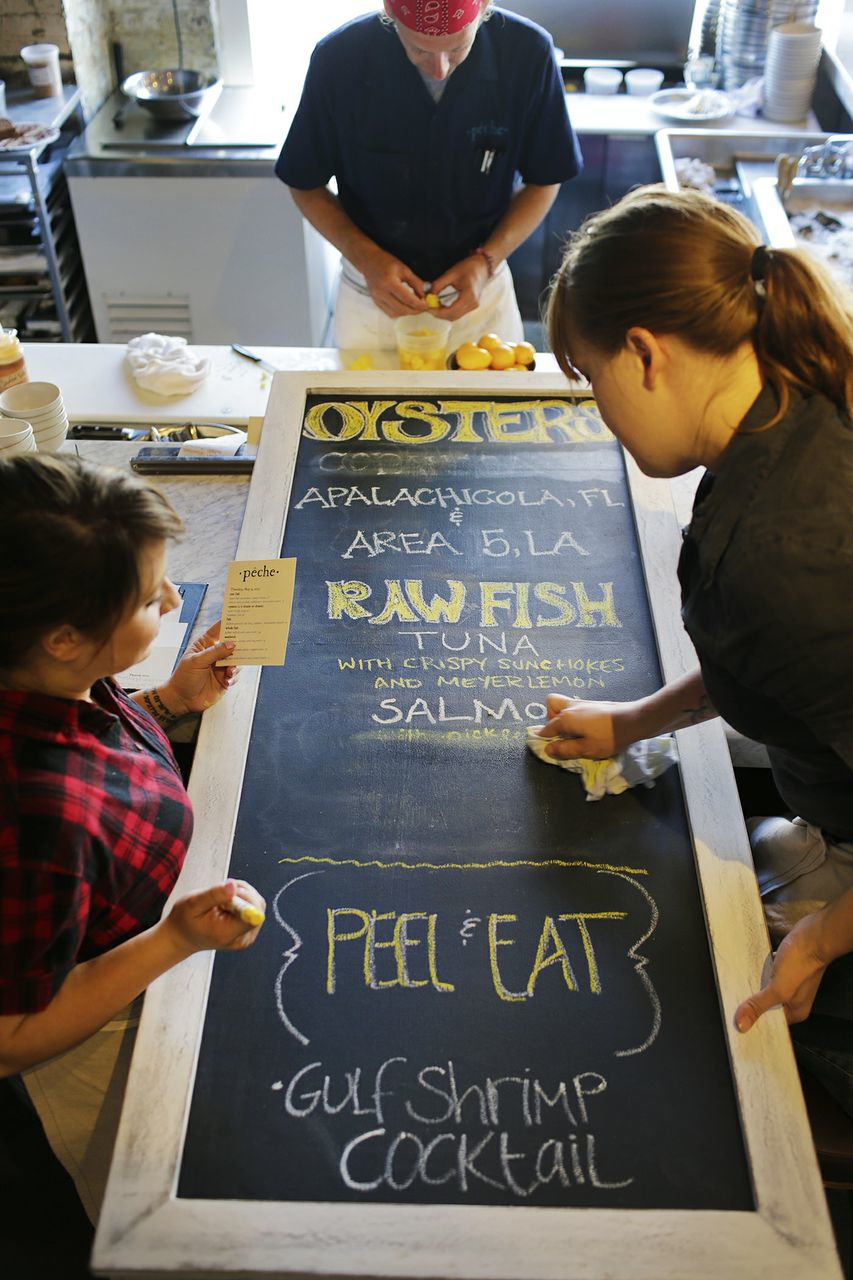
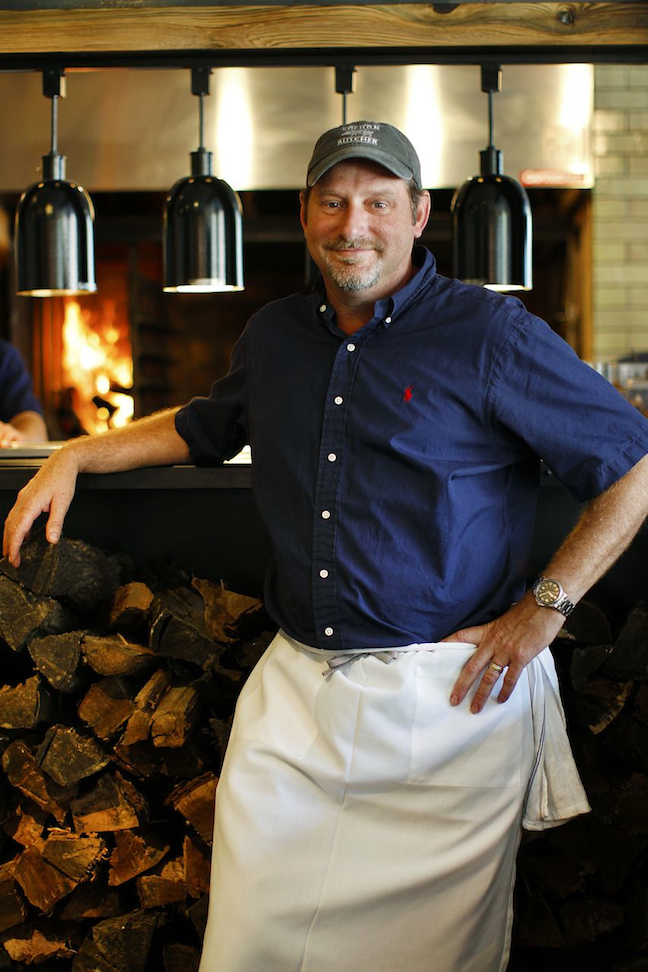 PÊCHE
PÊCHE
800 Magazine Street
http://www.pecherestaurant.com
I
have waited until now to report on Donald Link’s
new seafood restaurant, Pêche, because when
I ate there last year, the noise level in the
former warehouse space was so blisteringly high
that I could never recommend it.
It was, apparently, of
great concern to Link (left), too, for he went through
many changes to tamp the noise down, and, according
to a report in a local newsfeed, the restaurant is
now fit for human occupation.
If
there
have been any culinary changes since last year, I
can’t really say, but the intent of Pêche was
to do things simply and let the Gulf ingredients
speak for themselves with not too much chef-ing
going on. It’s a formula that’s worked for
Link at his hog-based restaurant Cochon and his
wonderful modern Creole place, Herbsaint--both among
my very favorites in town. 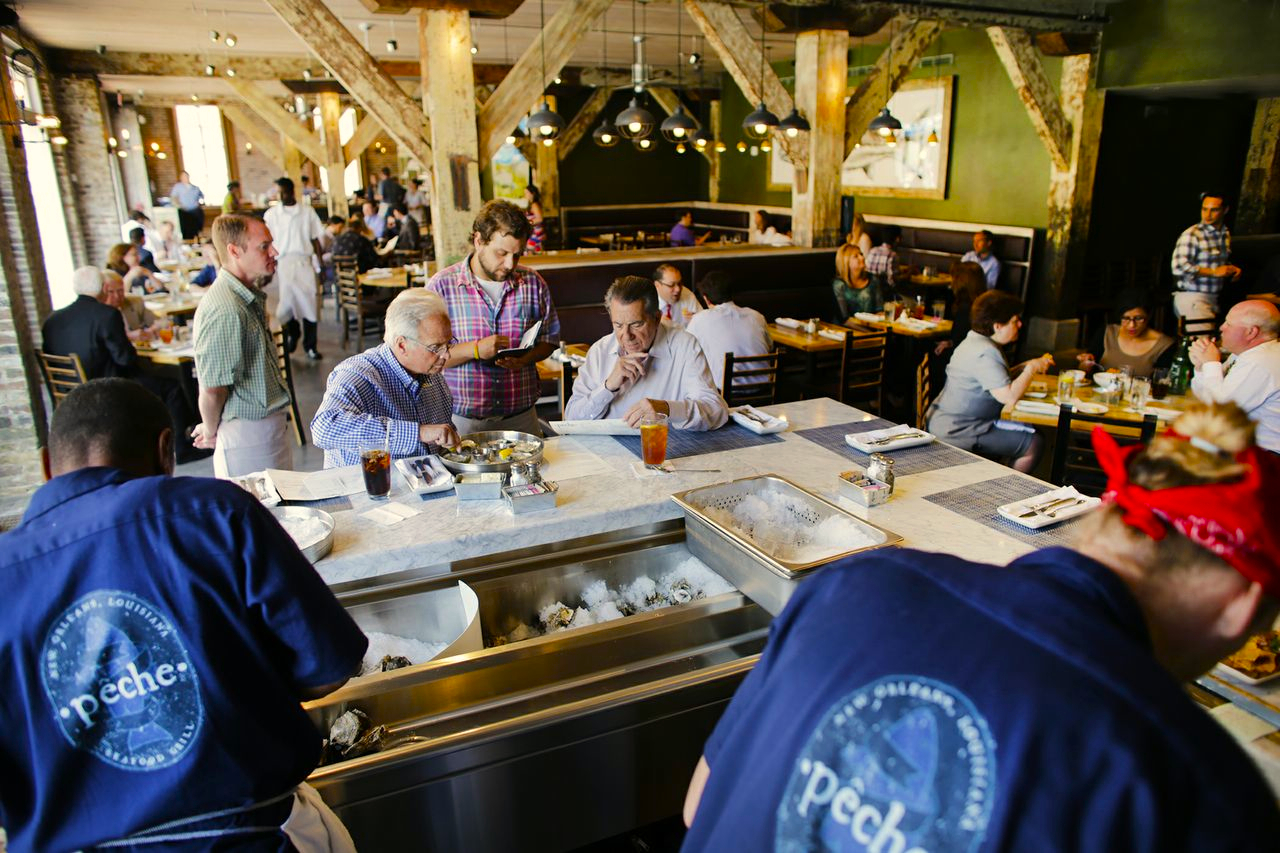
With chef-partners Ryan Prewitt
and Stephen Stryjewski, Link has kept to the
basics here, with a compact menu of raw items
(priced daily), and some snacks like shrimp toast
($7) and delicious shrimp-and-fontina croquettes
($10). Then there are small plates, like catfish
with pickled greens in a hot chili broth ($10), and
even some non-seafood items like grilled chicken
with a white barbecue sauce ($12).
The stars of the show at
Pêche are, obviously, the impeccably fresh
fish (market price), grilled to the right
temperature and served with very little but lemon
and oil. They are listed on the blackboard
each night (above),
along with the peel-and-eat shrimp when Link can get
the best of them.
Travel & Leisure,
without saying why, named Pêche one of the
"Ten Most Romantic Restaurants" in the USA; I
certainly don't see Pêche that way, but I’m all ready to go back,
no ear plugs this time. I always thought Link
would bring it off.
Open for lunch and dinner daily.
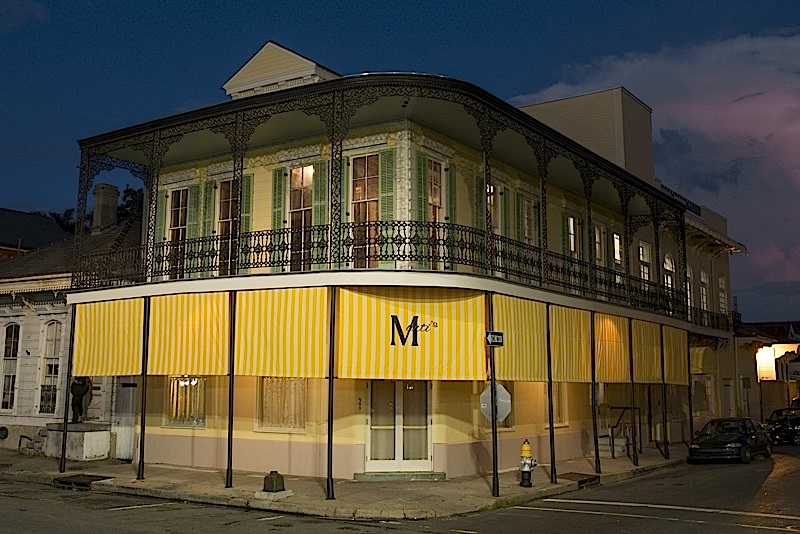 MARTI’S
MARTI’S
1041 Dumaine Street
504-522-5478
http://martisnola.com
Marti’s
is
a real breath of fresh air in an old venue.
A very long time ago the premises used to be
Gentlich’s, a bar and sandwich joint, then a full
service Creole restaurant called Marti's,
whose clientele consisted largely of the arts,
theater and gay communities. Tennessee Williams
lived across the street and was a regular.
From
1988
through 1991 the restaurant was closed, then turned
into Peristyle, named after the beautiful
murals of City Park. It became Wolfe’s for a
while, then last year Patrick and Rebecca Singeley,
who own Gautreau’s, opened it up and took back the
name Marti’s, giving the room a period art
déco style, with elegant chandeliers, and
banquettes in pale blue-green leather. But
this is not an effusively posh place either.
As you enter there is a serious bar with
a serious barman--not a place to hear the new Jay Z
CD or watch women’s golf. You may, though, run
into actors making movies in town, as have Jessica
Lange, Sofia Vergara and Ryan Reynolds. 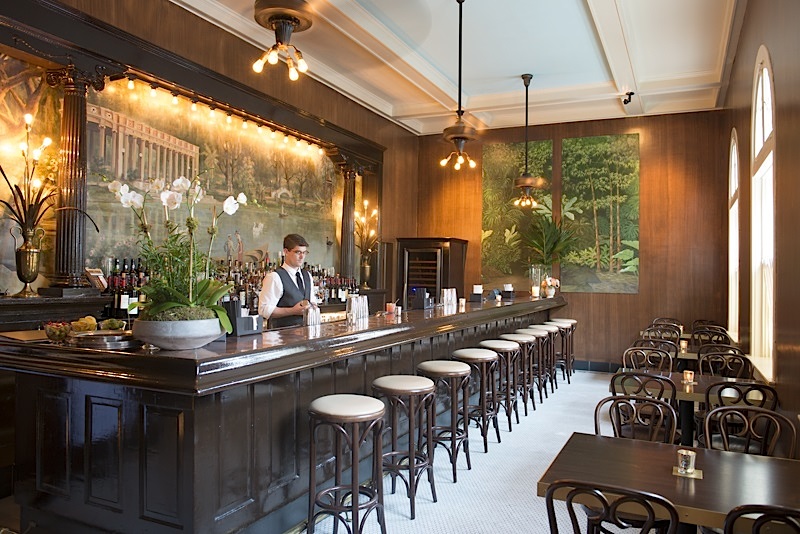
Marti’s
chef,
formerly at Gautreau’s, is native Louisianan Drew
Lockett, and it is more than evident how much care
he puts into his cooking. Textures,
seasonings, temperature are all as they should be.
Flourishes are few, tradition is respected,
creativity shows well. Indeed, I wrote superlatives
next to most of the dishes I tried, beginning with
seared foie gras with smoked salt, green tomato jam,
and white balsamic ($18). Excellent in every respect
was his bucatini with rabbit ragù, tomatoes,
roasted garlic, sage and pecorino ($14), and I
haven’t had a better risotto in New Orleans than
Marti’s, with corn, tender shrimp, mushrooms and
white summer truffles ($15).
There are seven shellfish options, admirably
conservative, and the Gulf fish amandine with
green beans, lemon, and brown butter was sweet and
perfectly cooked. (I do wonder why, in a city like
New Orleans, Lockett even bothers bringing in King
salmon from the Pacific Northwest.)
Rabbit
served
two ways ($29) came as braised legs and grilled
sausage, with mustard greens, dirty rice and rabbit
jus, while
a duck leg confit ($28) was enriched with just
enough chickpeas, silky eggplant, roasted peppers
and tomatoes. Something simple and simply good was
his crispy pork Milanese with mustard sauce, greens,
lemon and shallots ($27).
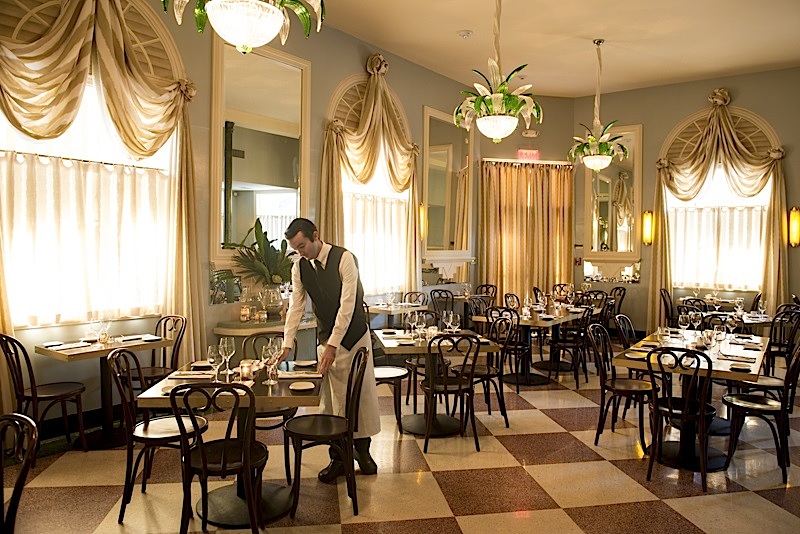 Oddly
enough, desserts are not what leap to mind in
food-mad New Orleans, but the dark chocolate pot de
crème with salted caramel ($11) is
very good. Not so the mediocre ice creams and
sorbets ($6). The wine list is both solid and
reasonably priced, though young in red vintages.
Oddly
enough, desserts are not what leap to mind in
food-mad New Orleans, but the dark chocolate pot de
crème with salted caramel ($11) is
very good. Not so the mediocre ice creams and
sorbets ($6). The wine list is both solid and
reasonably priced, though young in red vintages.
In many ways Marti’s treads a
fine and welcome line between tradition and
contemporaneity in its cuisine. Its beauty has
good bones, its hospitality is infectious, and the
level of sophistication is just about perfect
without ever being elitist. Marti’s rings true on
every level. It’s an honest place to dine.
Open nightly for dinner.
SQUARE
ROOT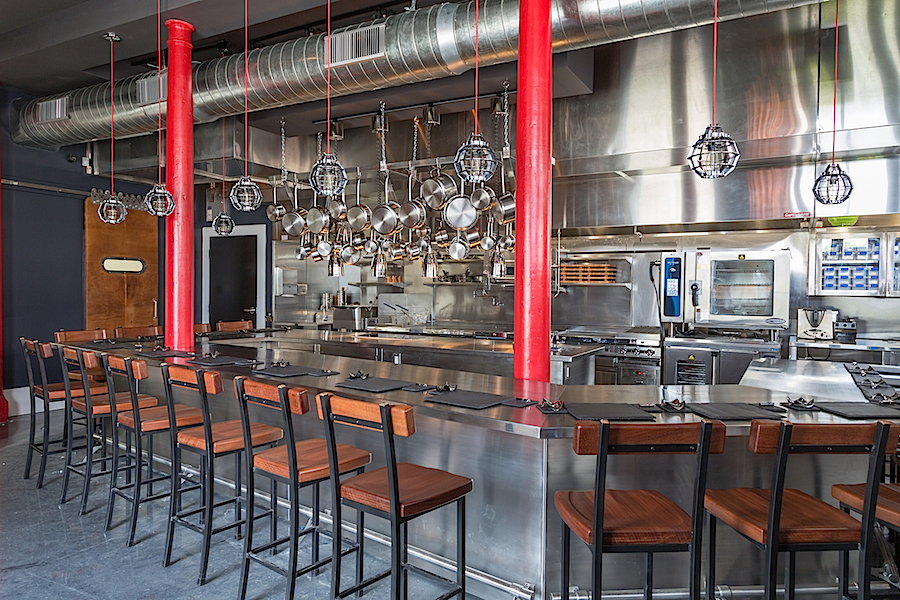
1800 Magazine St.
504-309-7800
I was no fan of the
modernist pretensions of Chef-owner Phillip L.
Lopez (below, in
the middle) and partner Maximilian G.
Ortiz’s first venture, Root, of which the Times-Picayune
critic wrote, “To fully appreciate the cooking of
Root’s chef-owner, Phillip Lopez, it’s necessary
to surrender yourself to his ambition [and] to the
crosswind of exhilaration and mystification that
is both the price and reward of eating here.”
So I was not anticipating a fabulous meal at their
new Square Root on Magazine Street. In fact,
Square Root goes even further into
molecular/modernist cuisine via tasting menus
comprising from 8 to 15 courses ($95-$150 per
person) that can easily last three hours. The
second floor is home to Root2, an artisanal
charcuterie, cheese and cocktail bar. The
wine cellar stocks 3,000 bottles, though matching
them with this kind of food is extremely
difficult.
There are only 16 seats in the rustic, modern
dining room, with its Japanese shou-sugi-ban
wood wall and cement floors. You sit in front of a
U-shaped counter and very open kitchen where the
crew works feverishly, tweezers at the ready; a
waiter, for some reason, wears one white glove.
Cooks clean each plate with vinegar and water.
The food is prepared and served right in
front of you, with each dish taking about two
minutes of extended, breathless explanation.
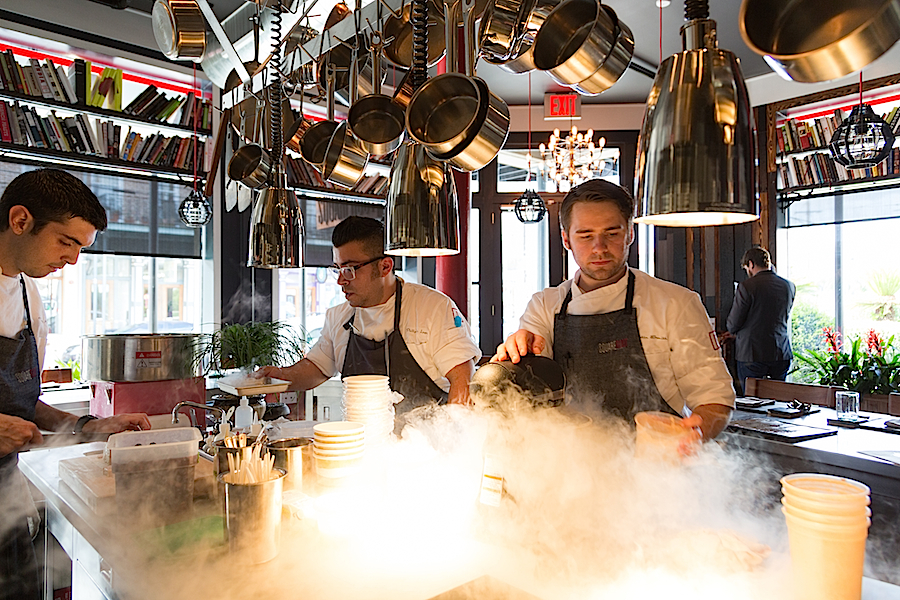 You
begin with “snacks,” which on the night I was
there included one lobster cracker with tarragon,
caviar, lobster bergamot mousse, and flowering
coriander, and a really wonderful pizzette with
smoked n’duja
jam with squash preserves, toasted seeds,
pecorino, and fennel. Then came a country-fried
chicken wafer and pickled fried okra, smothered
with the sharp tastes of fermented mustard seeds,
and dill--this, in a city of great fried chicken,
almost seems a snub of the entrenched tradition.
You
begin with “snacks,” which on the night I was
there included one lobster cracker with tarragon,
caviar, lobster bergamot mousse, and flowering
coriander, and a really wonderful pizzette with
smoked n’duja
jam with squash preserves, toasted seeds,
pecorino, and fennel. Then came a country-fried
chicken wafer and pickled fried okra, smothered
with the sharp tastes of fermented mustard seeds,
and dill--this, in a city of great fried chicken,
almost seems a snub of the entrenched tradition.
Black duck
tortellini with a single dried wakame chip,
coco nib rice crisp, duck and sour dashi, and wild
oxtails (where does one buy “wild” oxtails?) was a
tasty and impressive tour de force. It’s one thing
to be, as Ortiz says, “playful” by matching
pheasant with a peppered corn pudding, corn
croutons, huitlacoche
velouté and popcorn shoots, but it’s way
over the top to create a dish that’s taking me two
minutes just to type: confit potatoes, za’atar
potato crisps, white vermouth gelée, smoked
caviar, truffle pickled peaches, and Yukon Gold
potato soup, which sounds like an entire menu on
one plate.
The red meat dish was
charred Louisiana wagyu-style
beef
with squash, miso, hazelnut pomace, bone marrow
soubise, and aged balsamic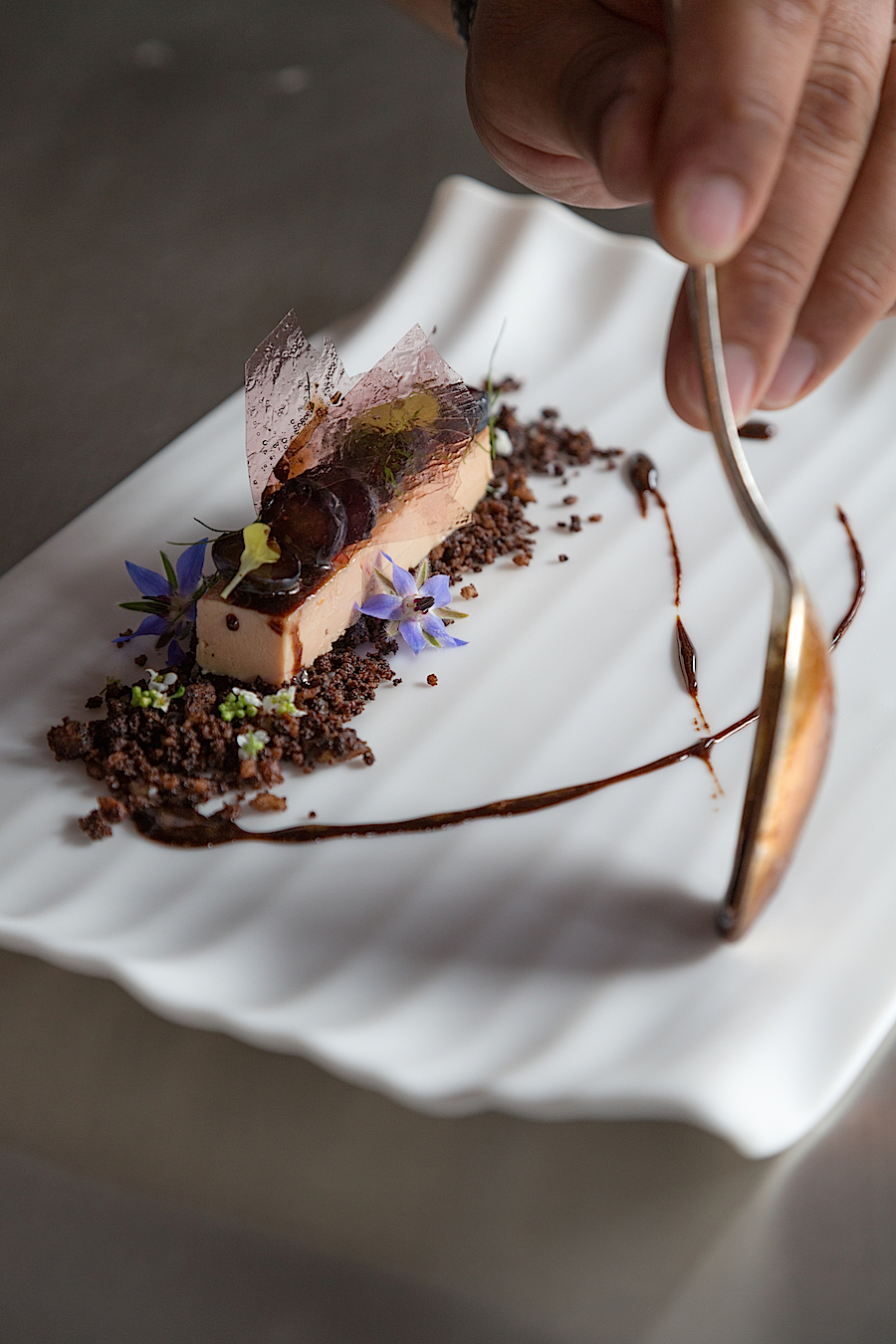 vinegar, which, despite
all that came before, I ate ravenously because I
was still hungry.
vinegar, which, despite
all that came before, I ate ravenously because I
was still hungry.
There’s
no doubt that Square Root is an adventurous night
out--and the owners say the menu changes all the
time, which hardly allows any dish to be
perfected. So, when Ortiz told me that he
pressed kale leaves between the pages of Volume
VIII of the Encyclopedia
Brittanica, I had no reason to doubt his
claim, though I later learned he was joking.
Reservations (taken only through Open Table) are
said to be very tough to score, but on the
Thursday night during the busy New Orleans Food
& Wine Experience, the place never filled up
and by 9:30 was more than a third empty. In
fact, I just checked Open Table for two seats
tonight and they can take me at 6, 6:30, 8:30 or 9
p.m.
It’s
really
up to you to decide if this is the kind of dining
“experience” you're up for in New Orleans.
It is exciting, it is ambitious, you’ll be
impressed and you’ll laugh; it’s just not for
everyone. But one way or the other, they’d better
re-think the fried chicken.
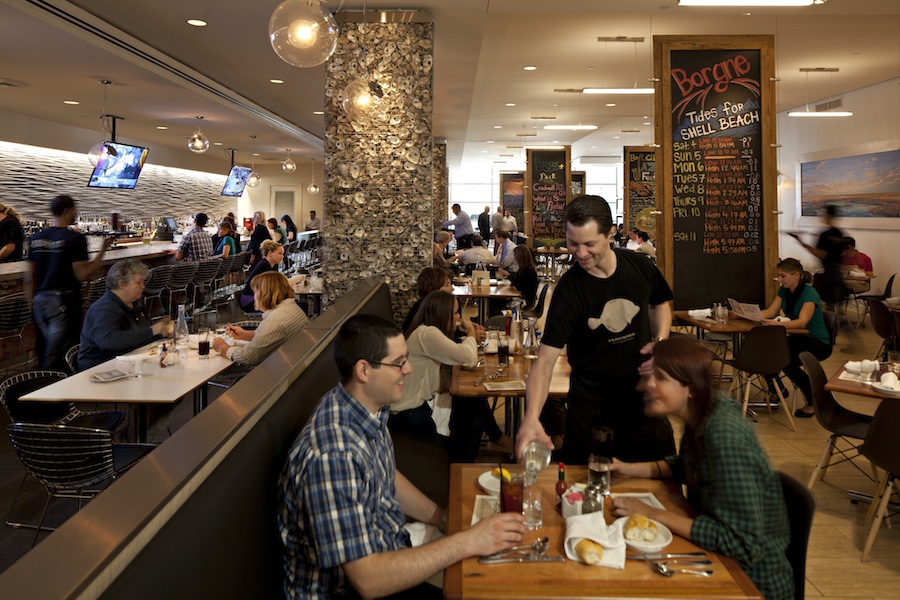 BORGNE
BORGNE
Hyatt
Regency New Orleans Hotel
601 Loyola Avenue
508-613-3850
neworleans.hyatt.com
The
wholly
renovated Hyatt Regency, heavily damaged by
Hurricane Katrina, has, like so many properties
in New Orleans, come back stronger and better
than ever.
That cost $275 million, but it
shows. There are now several food
alternatives within the hotel, including the 8
Block Kitchen & Bar; a sports restaurant named
Vitascope Hall, and a barbeque eatery named Q
Smokery & Café. But the most
serious of the restaurants is one with the
involvement of Chef John Besh, who also has August
and other restaurants around town.
Borgne’s executive chef, Brian Landry,
sets a table with focus on the Gulf, and you could
happily make a meal of his starters and small
plates, like the dozen oysters for $15.
“Hunting camp style” duck poppers with
jalapeño and bacon ($10) were way too
sweet, and there wasn’t much meat on a special of
turkey necks ($10). Jumbo shrimp
rémoulade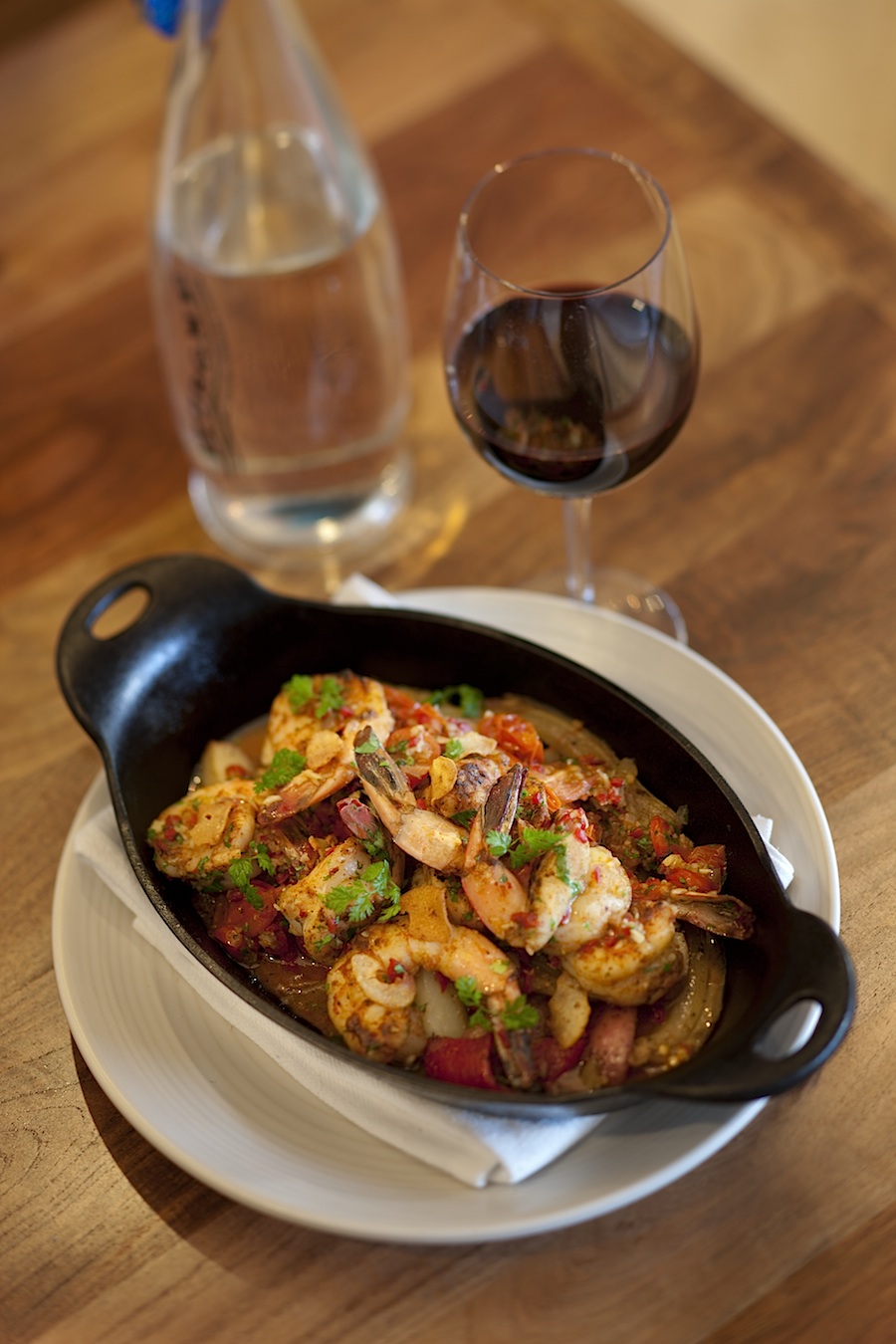 with
petit iceberg lettuce and quail egg ($12) was as
good as any in town, while the cream of corn soup
with plenty of crabmeat ($8) was better than any
in the city, almost equaled by a lusty duck and
andouille gumbo with rice ($8).
with
petit iceberg lettuce and quail egg ($12) was as
good as any in town, while the cream of corn soup
with plenty of crabmeat ($8) was better than any
in the city, almost equaled by a lusty duck and
andouille gumbo with rice ($8).
The
best
of the entrees I tried was deliciously moist black
drum fish cooked à la
plancha, sauced with rich brown butter,
toasted pecans and truly jumbo lump crabmeat ($30).
Another shrimp dish, with a mass of garlic
cloves, tomatoes and roasted eggplant and fregola
($24), was excellent because the quality of the
shrimp was.
For
dessert,
it’s hard to resist the Key lime ice box pie with
ginger and black rum ice cream ($7), or the
chocolate hazelnut pudding with a condensed milk
sorbet ($7).
Borgne
is
located in a hotel, and the room looks it--big,
wide, and terribly loud, especially towards the
middle and rear, with harried waiters. The
décor does not exactly reek New Orleans,
looking more like a big Miami Beach
luncheonette. I think it’s probably a
better lunch bet than for dinner.
Open for
lunch and dinner daily.
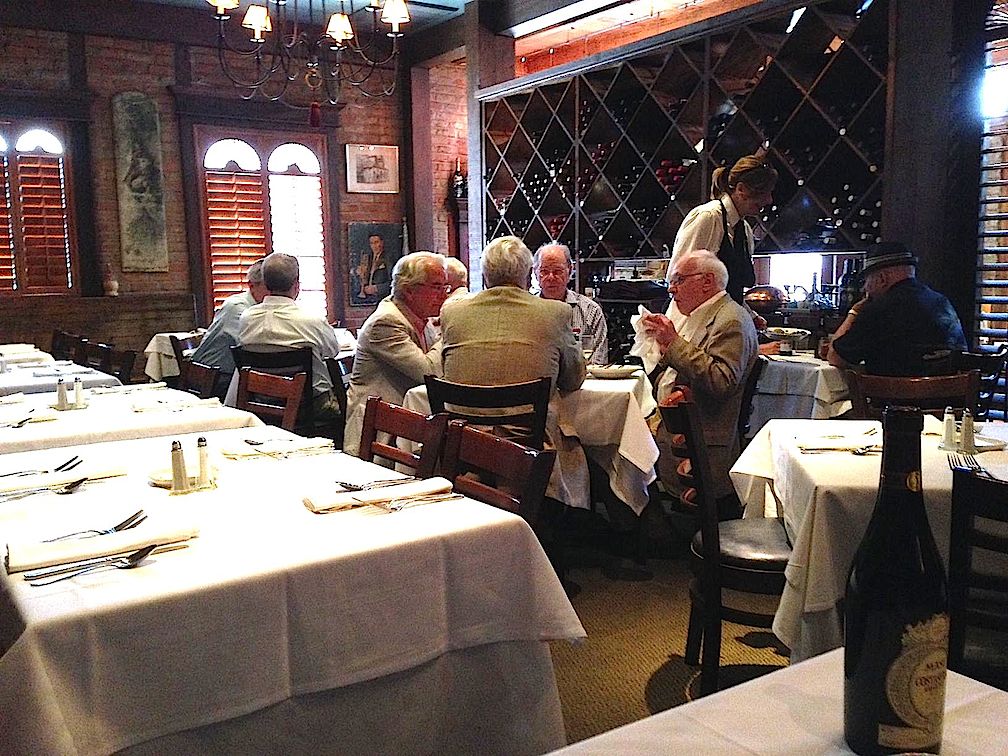 ELEVEN
79 RESTAURANT
ELEVEN
79 RESTAURANT
1179 Annunciation Street
504-299-1179
http://www.eleven79.com
You
might
well think that Eleven 79 Restaurant dates
back before the war--that’s World War II--for
when you walk in, the place has a well-worn,
bar-lounge atmosphere and décor that
might well have attracted all the star jazz
singers whose paintings and photos deck the
walls. Owner Joe Segreto (the skinny fellow in
the white linen suit below) knew them all,
many before he opened the restaurant in 1996.
Ask him about the old-timers and he’s
got stories to take you right through dessert.
And his guests, most of them very
regular regulars, could tell you a million
more. 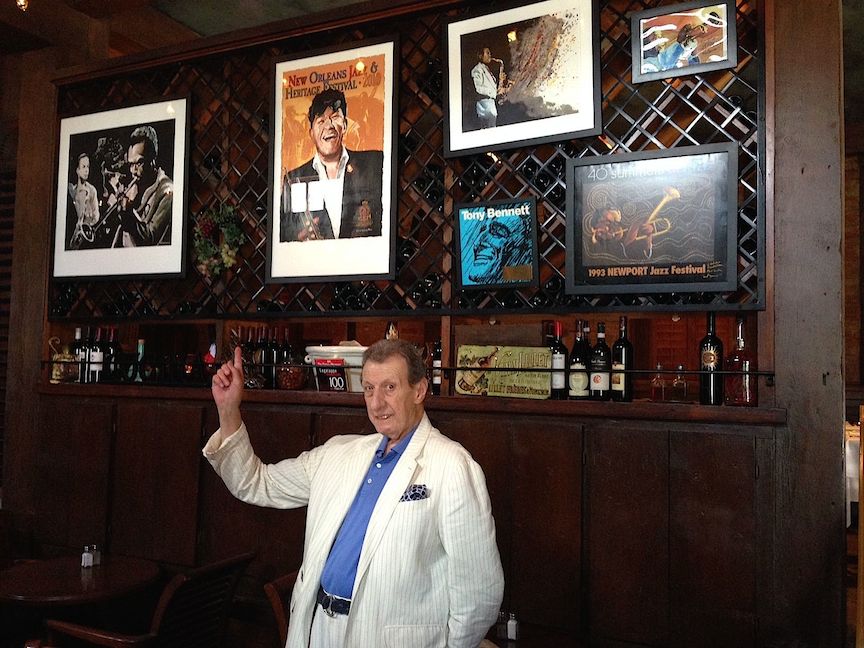
The
menu
at Eleven 79 hasn’t budged much since opening day:
it’s straight-down-the-line Italian-American fare
whose principal claim is that they’ve perfected
everything over the years, starting with a
terrific, deep, rich tomato sauce (marinara or
meat) that graces the spaghetti and fettuccine
($16.50). They make a fine creamy Alfredo
($17.50), too, and one of the most popular items
is pasta with oysters, spinach, olive oil,
mushrooms and green onions ($20).
The
fried
calamari ($10.50) and eggplant parmigiana ($8.50)
make for first-rate starters.
Everyone
in
the know orders the gigantic meatball (below) as a
course on its own, bigger than a softball and
lavished with meat sauce. This you won't find
anywhere else in the city; indeed you won’t find
it on Joe’s menu either, because people just know
about it and order it. There is a lot of veal on
the menu--eight items, including saltimbocca, veal
milanese, osso buco and veal Eleven 79, piled with
roasted peppers, asparagus and 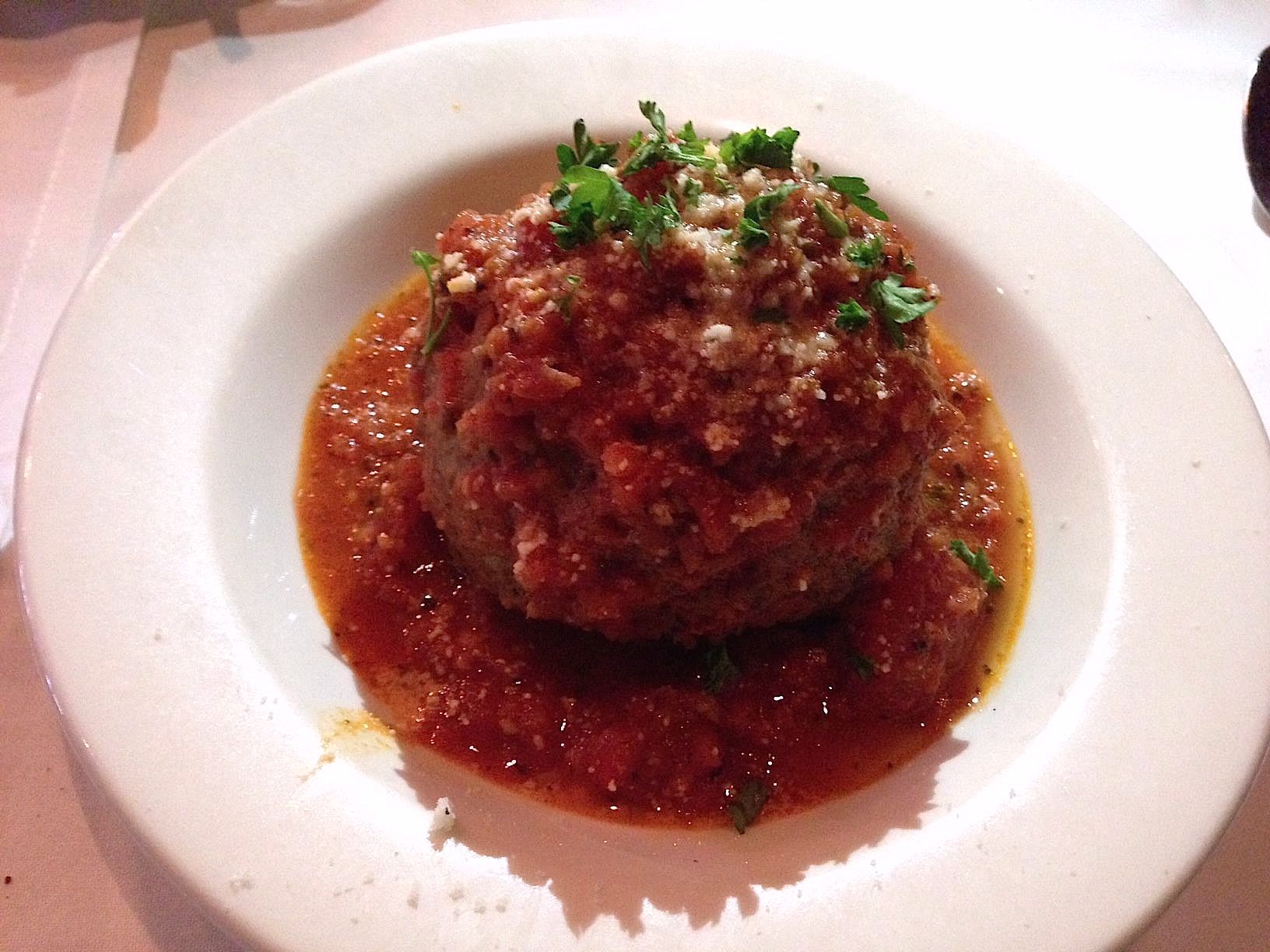 mozzarella.
In a seafood town like New Orleans,
I’d expected a lot more seafood main courses.
Catch of the day is pretty close to sum total.
mozzarella.
In a seafood town like New Orleans,
I’d expected a lot more seafood main courses.
Catch of the day is pretty close to sum total.
The
ice
cream comes from the local Angelo Brocato’s, so
you know it’s among the best in town, and Joe has
some pretty interesting bottlings on and off the
wine list.
Eleven
79
is about as far from Square Root as you can get in
New Orleans, and for a whole lot of people, that’s
just fine with them. Joe himself is one of
the draws at his restaurant. Go once. He’ll
remember you next time.
Lunch is
served only Thurs. & Fri.; Dinner Tues.-Sat.
❖❖❖
BARE
NAKED TABLES
By John Mariani
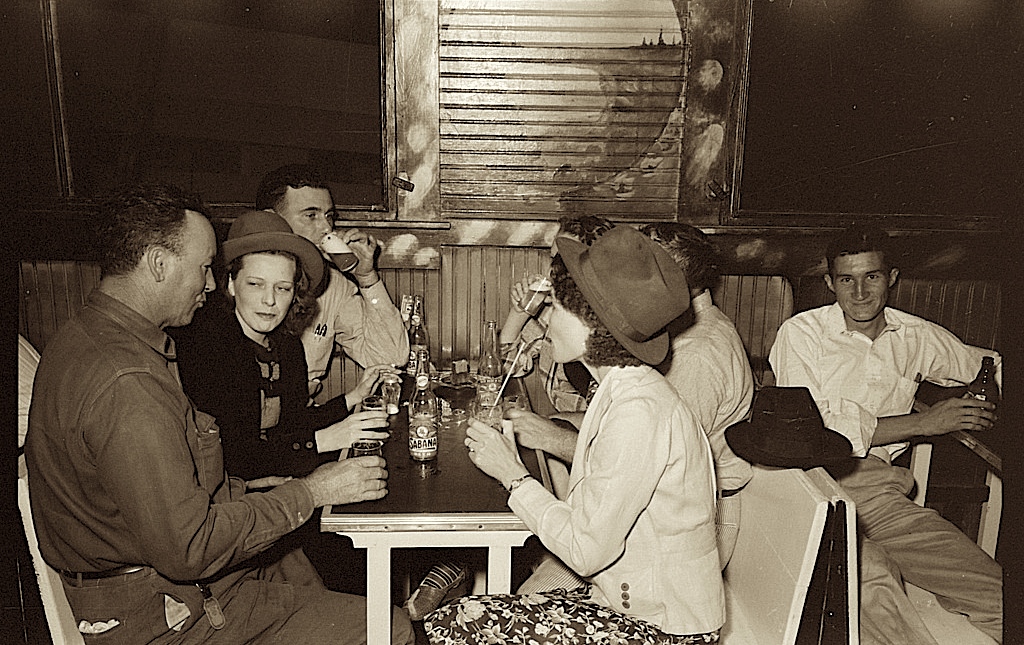
Anyone who has dined out with me knows
that, unless I’m eating at the proverbial hole in
the wall, I tend to groan over the lack of what
was once the simplest amenity in a restaurant: a
tablecloth.
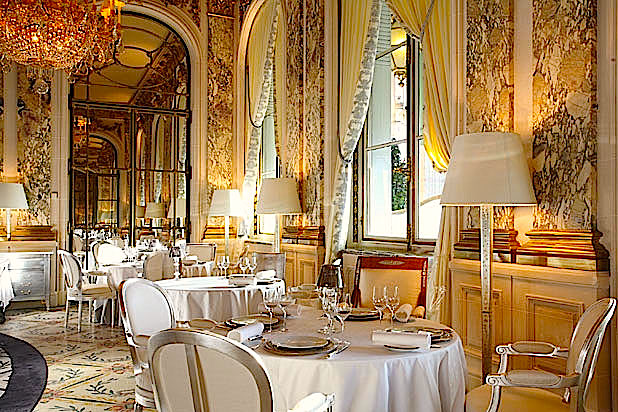 In the past,
even a pizzeria or Chinese eatery would have
tablecloths, and not just because it’s a nicety.
There are very good reasons for it: as any
epidemiologist will tell you, you can catch other
people’s illnesses through skin contact as much as
through sneezing or even kissing. So a barely
wiped bare wooden or Formica table is a festering
point for germs.
In the past,
even a pizzeria or Chinese eatery would have
tablecloths, and not just because it’s a nicety.
There are very good reasons for it: as any
epidemiologist will tell you, you can catch other
people’s illnesses through skin contact as much as
through sneezing or even kissing. So a barely
wiped bare wooden or Formica table is a festering
point for germs.
Restaurant at the
Meurice, Paris
A
tablecloth also provides brightness (unless it’s
black) and a bonhomie that bare, cold, hard wood or
plastic will always lack. Your hands don't stick to
cloth; drips and spills seep into it, not onto your
clothes; a tablecloth also soaks up noise in a
restaurant, while a hard surface bounces noise
around; and a tablecloth is easily cleared and
crumbed by a waiter, while cleaning a hard surface
is awkward and ineffective.
Esthetically speaking, a tablecloth is itself a
design statement about the degree of luxury a
restaurateur wants to manifest, whether the cloth is
simple cotton, damask or embossed linen. And,
as the photos below show, a restaurant need not be
"fussy" to have them. But, over the past five
or so years, the absence of tablecloths in
restaurants has been hailed as signaling the place
is not “fine dining,” meaning pretentious, even if
the cloth-less restaurant charges a small fortune
for its food.
Such restaurateurs call it a “design
statement” when, in almost all cases, it is nothing
more than a matter of trying to save money. And I
admit that such laundry bills can mount up--tens of
thousands of dollars per annum. But not using
tablecloths doesn’t seem in any way to reduce the
price of a meal at such restaurants.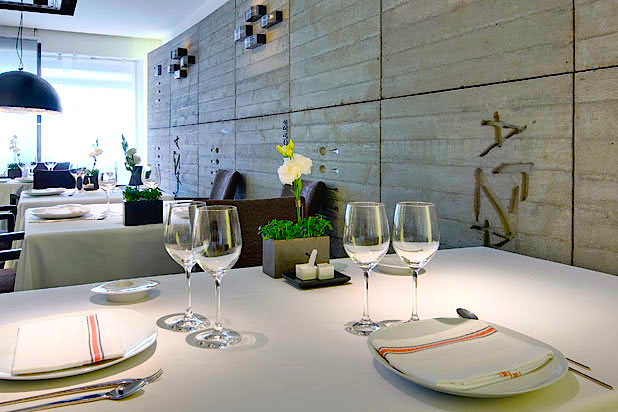 Believe me, your dinner
is never
cheaper because the restaurant doesn't use
tablecloths.
Believe me, your dinner
is never
cheaper because the restaurant doesn't use
tablecloths.
To
those restaurateurs who have yanked the tablecloths
from their tables, while insisting it’s part of
their design statement, I respond that colorful
plastic cups, knives and forks, and patterned paper
napkins might well be a design statement too and
would save them a lot more money,
but we haven't descended that low yet, except,
maybe, on airplanes.
Arzak, San
Sebastián
So, it was with some degree of
satisfaction that I read The Daily Meal’s
round-up of “The
101 Best Restaurants in Europe,” voted by
noted chefs and food media (including myself), and
found that the overwhelming majority are elegantly
appointed with tablecloths. This is
in complete contradistinction to Bon Appetit’s
recent article on “The Best
New Restaurants
in America 2014," which I wrote about in the Virtual
Gourmet, wherein not one restaurant uses
tablecloths.
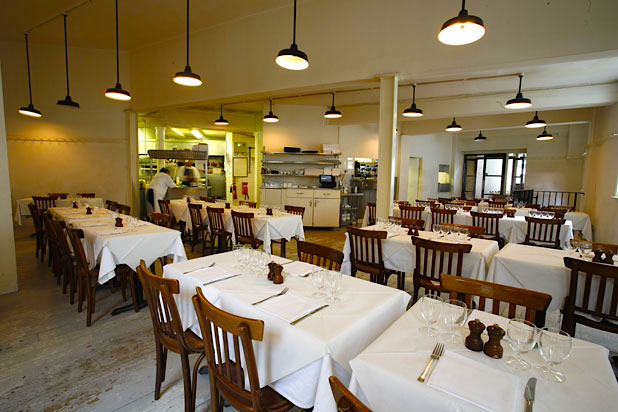 Peruse The Daily Meal’s
list and you’ll find that tablecloths are but a
minor item in the details that make these places so
respected: great chefs, great service, fine
décor, good silverware and wine glasses,
beautifully printed menus, well-dressed staff, great
wine lists. These are the things that make them
great.
Peruse The Daily Meal’s
list and you’ll find that tablecloths are but a
minor item in the details that make these places so
respected: great chefs, great service, fine
décor, good silverware and wine glasses,
beautifully printed menus, well-dressed staff, great
wine lists. These are the things that make them
great.
St. John, London
So, when
the American food media--and increasingly their
London counterparts--declare that fine dining is all
but dead and “white tablecloth restaurants are a
thing of the past” where no one wants to eat any
more, I invite anyone to try to book a 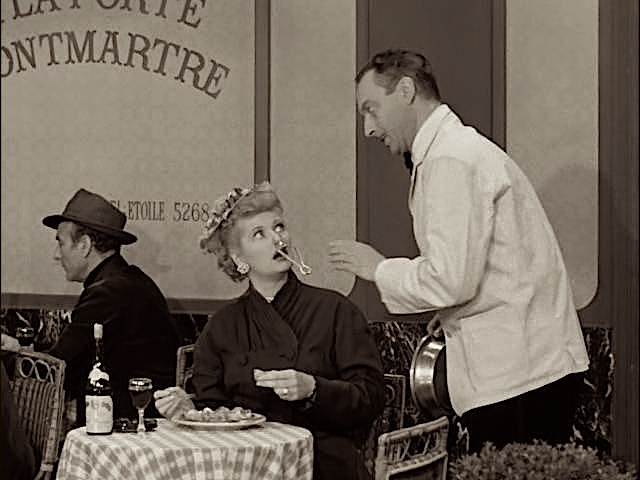 table at any of these 101
stellar restaurants on short notice. Try for a
week in advance, maybe a month.
table at any of these 101
stellar restaurants on short notice. Try for a
week in advance, maybe a month.
One of the first to rip away the tablecloths was the
Judge Judy of TV food competitions, Tom Colicchio,
who this week announced he would open a new
restaurant that would not have a formal setting
because, he said, "I don't think people are
interested in eating like that anymore." On the
other hand, one of
NYC's finest chefs, Floyd Cardoz, has just opened
White Street, with crystal chandeliers, tufted
leather sofas, and white tablecloths, described by
the owners as "classy old school New York
ambiance." The truth is, fine dining--and
tablecloths--are no more passé or dying than
are the works of Shakespeare, Jane Austin, Charles
Dickens or Tolstoy.
Now, of course, if the readers of
the foodie media are the kind of people who feel ill
at ease in a fine dining restaurant--remember Lucy
ordering snails in Paris on “I Love Lucy”?--that’s
their problem. For, if they learned a little more
about fine dining and its attendant pleasures,
including the softness of a thick tablecloth, they
might well be converted. And get less splinters in
the bargain.
❖❖❖
by John Mariani
THE RED CAT
227 10th Avenue (near 23rd Street)
212- 242-1122
http://www.theredcat.com/redcat.php
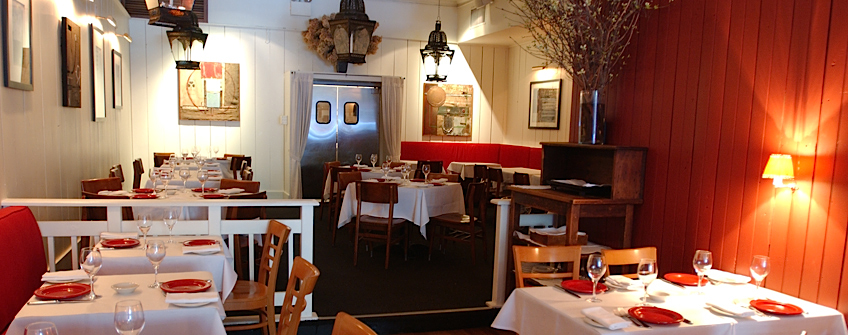 I’m
afraid the once gentle term “laid back” has
come to mean a restaurant where no one puts
any thought into the comfort of its guests and
where service means little more than sticking
a plate in front of you.
I’m
afraid the once gentle term “laid back” has
come to mean a restaurant where no one puts
any thought into the comfort of its guests and
where service means little more than sticking
a plate in front of you.
For an elementary course on what “laid back”
should mean at its best, a visit to the
fifteen-year-old Red Cat in Chelsea is in order.
There the first sign of civility may well be the
greeting by owner Jimmy Bradley (below), whose
sincere interest in your well-being while under
his care has been amiably bred into his entire
staff. That’s just one of the reasons
why Red Cat always has a large percentage of
regulars among its guests; the other percentage is
filled by those whom the regulars have brought.
Bradley also runs the equally pleasant restaurant
The Harrison in TriBeCa, and both share a desire
to please.
I did once think the dining room was very loud, but compared with many of the new restaurants opening south of Red Cat, the noise level is tolerable (and Bradley says he’s thinking about buffering it further).
The Red Cat’s scarlet-colored banquettes and simple slatted walls might put you in mind of New England rather than New York. Cozy seems too feeble a word to describe a place people find so truly lovable. It’s the kind of place where you feel entirely comfortable asking the person at the next table what it is she’s eating.
There’s a new chef aboard, Michael Cooperman (below), formerly of The Modern, and while his menu doesn’t stray from the original contemporary American style of The Red Cat’s past, he has brought a finesse that shows exactly just how much he learned from master chefs like Gabriel Kreuther (formerly at The Modern). Seasonings are in balance, textures are delicate, sauces enliven rather than mask fine ingredients, and the ideas are clearly all his.
Though
listed as a side dish, I enjoyed the light tempura
of green beans ($10) with a sweet hot
mustard dipping sauce as something to nibble on
with cocktails. The same might be said for
the impeccably rendered sauté of zucchini
with roasted almonds and a dash of ground pecorino
($11). The cool freshness of raw fluke
played well against sour tomatillo, aromatic
basil, lemon verbena and tomato ($16).
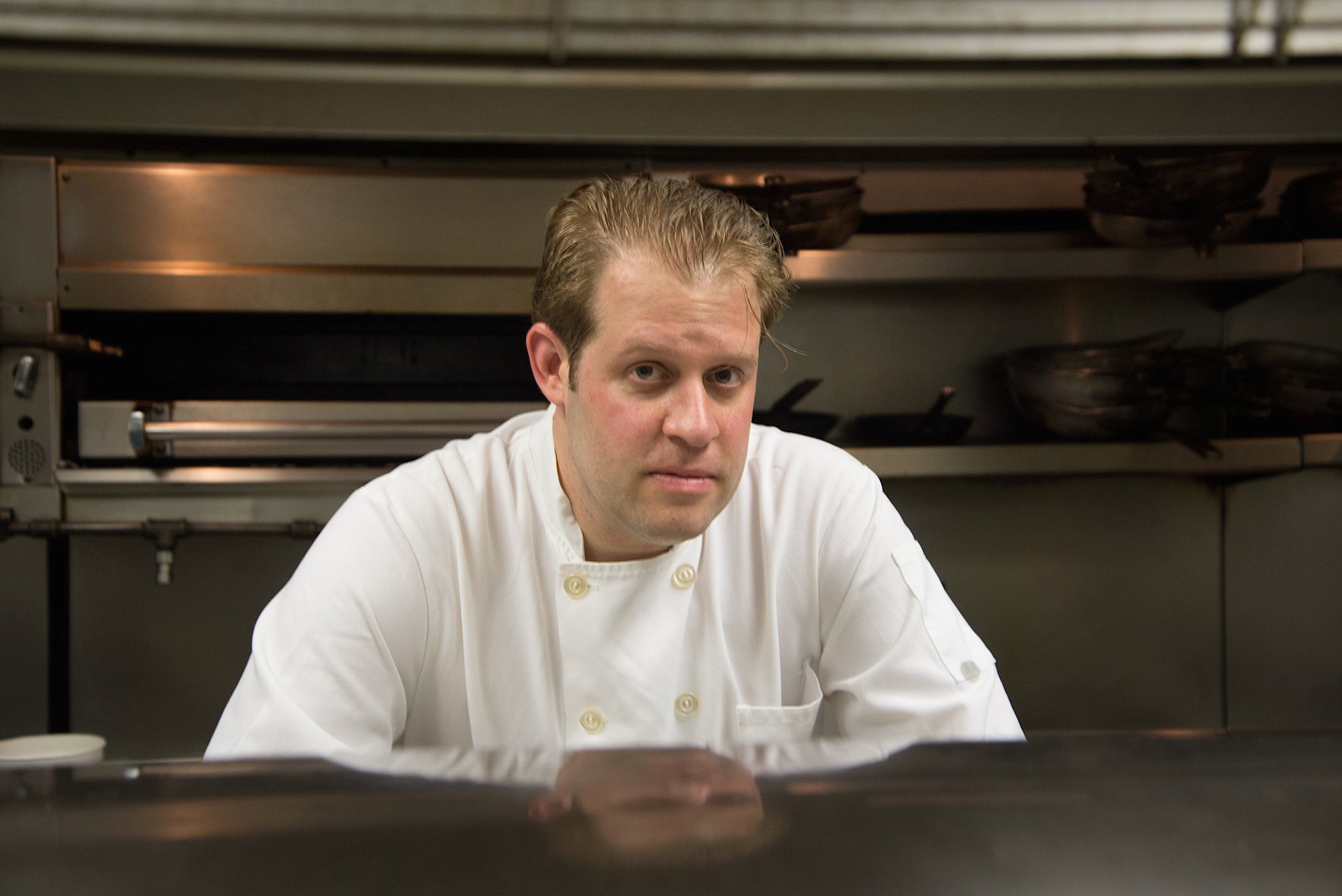 Diver’s
scallops ($18) had the same quality of freshness,
quickly seared on the plancha griddle just to give the
outside a texture, then served with sweet avocado,
cherry tomato, and a sprightly bacon
vinaigrette. Pasta, so often over-engineered
in non-Italian restaurants, was treated with
proper respect at The Red Cat in the form of
housemade cavatelli
with summer’s corn, a swirl of ricotta and some
spicy-hot ‘nduja
condiment, all graced with parsley butter
($15). Just as good and smack in season was
a plate of trenette
with golden zucchini flowers ($15). These
are the kinds of dishes that make eating anything
out of season seem utterly ridiculous.
Diver’s
scallops ($18) had the same quality of freshness,
quickly seared on the plancha griddle just to give the
outside a texture, then served with sweet avocado,
cherry tomato, and a sprightly bacon
vinaigrette. Pasta, so often over-engineered
in non-Italian restaurants, was treated with
proper respect at The Red Cat in the form of
housemade cavatelli
with summer’s corn, a swirl of ricotta and some
spicy-hot ‘nduja
condiment, all graced with parsley butter
($15). Just as good and smack in season was
a plate of trenette
with golden zucchini flowers ($15). These
are the kinds of dishes that make eating anything
out of season seem utterly ridiculous.
Of the entrees, I most liked the
skate with Swiss chard, raisins for sweetness, the
crunch of walnuts and a tomato-bread sauce
($26). The best of the main courses was a
well-spiced pork chop--and a hefty chop it
was--with orzo, chorizo, roasted broccoli and
green onions ($28). Tender and pink, the
chop never lost its flavor under the
spicings. An all-natural chicken with
arugula, radish, grilled lemon and salsa verde
($27) was fine enough if not out of the ordinary
in NYC, but I was disappointed with grilled calf’s
liver with braised Romaine lettuce, pancetta,
onion compote and tomato vinaigrette ($24),
because the inherent flavor of the liver didn’t
trump the other ingredients. The herbed
French fries ($9) were further testament that
making excellent French fries like these should
now be mandatory in all restaurants.
The desserts (all $10) keep in line with summer’s bounty, evident in a blueberry crisp with corn ice cream, mint, and streusel topping, and in a peach crostada with buttermilk sugar dough, luscious huckleberry ice cream and crème fraȋche. If you love chocolate and hazelnuts, the gianduja dessert here is going to make you deliriously happy.
I’ve noticed, looking back over recent reviews in this space, that new restaurants like Bacchanal and Batârd are trying hard not to try too hard, and The Red Cat has been achieving that delicate balance for a long, long while. There’s every reason to think that a lot of other places are just catching up.
The Red Cat is located at 227
10th Avenue; 212-242-1122.
http://www.theredcat.com/redcat.php
Open nightly for dinner, Mon.-Fri. for lunch,
and Sat. & Sun. for brunch.
❖❖❖
THE WINES OF THE VENETO
By John
Mariani
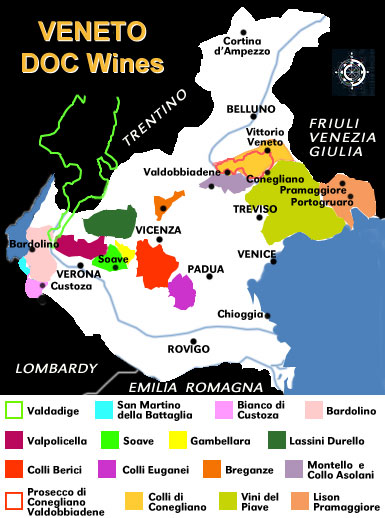 I’ll grant that feasting on
fish caught that morning in Lake Garda, Italy,
and served at the delightful Trattoria
Pompiere in Verona can have a
powerful effect on one’s objectivity. But
I was also able to overcome such distractions to
focus on the fact that the wines of the region,
the Veneto, get better and better all the time.
I’ll grant that feasting on
fish caught that morning in Lake Garda, Italy,
and served at the delightful Trattoria
Pompiere in Verona can have a
powerful effect on one’s objectivity. But
I was also able to overcome such distractions to
focus on the fact that the wines of the region,
the Veneto, get better and better all the time.The Veneto is Italy’s largest wine producer. The wines with D.O.C. and D.O.C.G. appellations alone come to more than 300 million bottles annually. The principal Veneto exporters are Bolla, Bertani, Allegrini, Anselmi, Maculan, Tommasi, Zonin, and Masi.
The best known wines, many made in tremendous bulk, are soave, bardolino and valpolicella, this last in particular showing more consistent quality than ever before. The most interesting of the modern valpolicellas have the word “ripasso” (re-passed) on their label, which means the wines spend time in contact with the dried grapes, a technique long used to make a much bigger, red wine named Amarone della Valpolicella, whose grapes dry on straw mats in order to concentrate their sugars and flavors. Ripasso valpolicellas take on some of Amarones’ fleshy character but are not as massive.
This summer, during the New Orleans Wine & Food Experience, I was on a panel called “Fresh and Dried,” on the subject of Veneto wines, led by Tony Apostolakos, brand manager of Masi Agricola, whose wines I’ve long admired. Masi has a 200-year history of innovation in the region, having refined the traditional technique
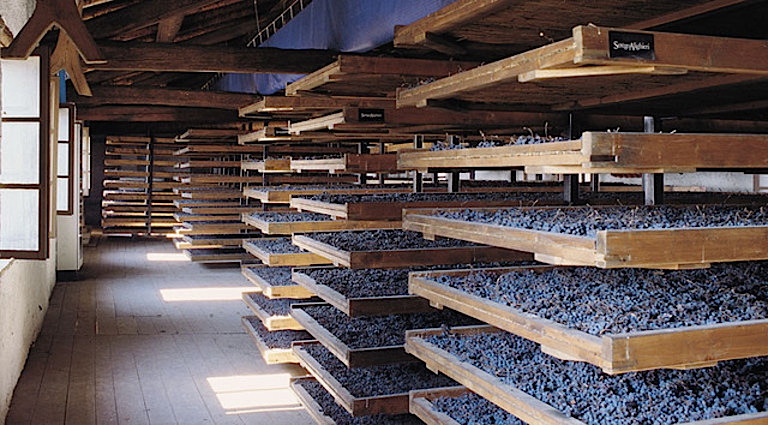 called appassimento,
by which grapes are dried to concentrate their
flavors and give them durability. Masi dries
corvina, rondinella and molinara grapes on bamboo
racks to give maximum airflow around the bunches (right). They
even semi-dry pinot grigio grapes, mixing
called appassimento,
by which grapes are dried to concentrate their
flavors and give them durability. Masi dries
corvina, rondinella and molinara grapes on bamboo
racks to give maximum airflow around the bunches (right). They
even semi-dry pinot grigio grapes, mixingtheir juice with 25 percent verduzzo to add a honey-like flavor.
Apostolakos was quick to point out, however, that, contrary to some assertions, the grapes are not dried to “raisin shrinkage.” Rather, he says, “They resemble more a party balloon that has lost its air and deflated” (below).
Masi is not alone these days in making Amarone della Valpolicella in a more drinkable style that does not take decades to develop. In the past, Amarone was expected to be a massive, high-alcohol, Port-like red wine, with a leathery taste and, more often than not, a bit of oxidation. A few producers, like Bertani, still go with that style, which still has its fans, but Masi and others have maintained the wine’s richness while removing the oxidation and high alcohol, allowing the wine to be drunk earlier and with a wider range of dishes.
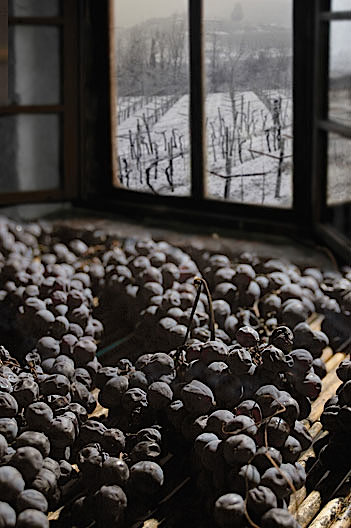 And,
when Masi determines that the vintage is not up to
its standards--which apparently happens every ten
years, in 1962, 1972, 1982, 1992 and 2002--it
doesn’t make Amarone. The great vintages, said
Apostolakos, are 1990, 1997, 2006, 2007 and
2011. I would still wait a couple of years for
the 2011 to mature, but mod ern Amarones can age for
a decade or more and still be sound and robust.
And,
when Masi determines that the vintage is not up to
its standards--which apparently happens every ten
years, in 1962, 1972, 1982, 1992 and 2002--it
doesn’t make Amarone. The great vintages, said
Apostolakos, are 1990, 1997, 2006, 2007 and
2011. I would still wait a couple of years for
the 2011 to mature, but mod ern Amarones can age for
a decade or more and still be sound and robust.Masi also has been proudly promoting a wine named Campofiorin Rosso del Veronese,
 which, since its debut in
1964, was its first ripasso, for which fresh corvina,
rondinella and molinara grape juices are blended,
with about 25 percent of the same grapes dried for
about six weeks. This causes a re-fermentation
called a malolactic. The result is a bigger, richer
wine than regular valpolicella. Though it is
not a legal classification, Masi calls Campofiorin a
“Supervenetian.” And, at under $15, it is an
amazingly good buy.
which, since its debut in
1964, was its first ripasso, for which fresh corvina,
rondinella and molinara grape juices are blended,
with about 25 percent of the same grapes dried for
about six weeks. This causes a re-fermentation
called a malolactic. The result is a bigger, richer
wine than regular valpolicella. Though it is
not a legal classification, Masi calls Campofiorin a
“Supervenetian.” And, at under $15, it is an
amazingly good buy.The bigger, brawnier brother of Campofiorin is the company’s Riserva di Costasera Amarone della Valpolicella Classico 2009 ($60), which is classified as a prestigious D.O.C.G. In this blend the corvina actually develops a bit of botrytis, a fungus that shrivels the grapes and concentrates the sugars, adding body.
Masi’s Bonacosta Valpolicella Classico D.O.C. ($12), on the other hand, is made exclusively from fresh grapes, going through malolactic on its own.
It’s a range of wines from the same grapes that shows how different--and differently priced--they can be, yet still remain their essential character and terroir.
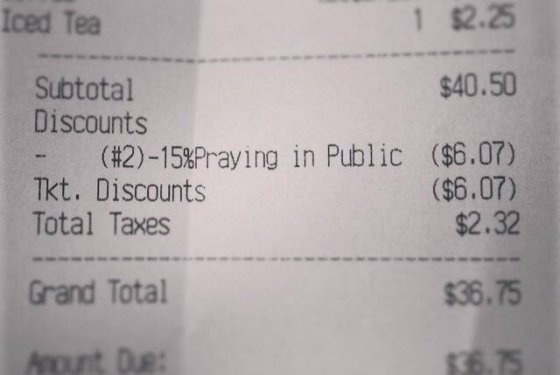
Mary's Gourmet Diner in Winston-Salem, NC, is taking
15 percent
off the check of any customer "praying in
public."
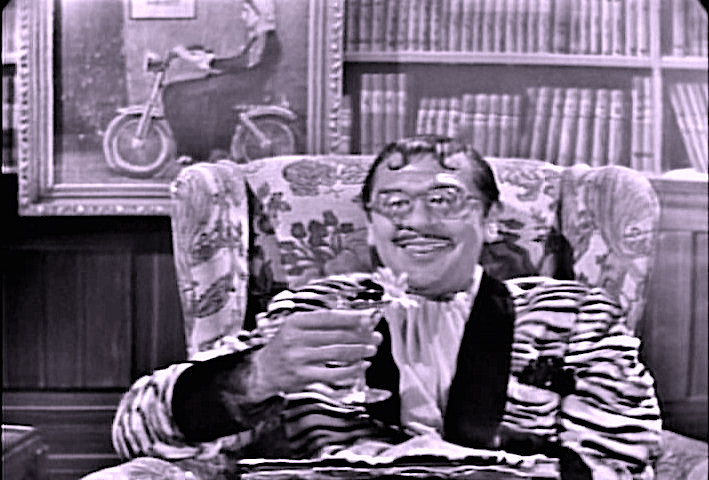
FOOD
WRITING 101: AVOID RIDICULOUSLY
ABSTRUSE
LITERARY REFERENCES
“On this most Brooklyn of
streets—one of those blocks in the Heights that
looks dreamt up by Auden, or perhaps
Dunham—there could be no Manhattan. `We’re
out of sweet vermouth,' the waitress explained.
“How about an Old-Fashioned?'"--Amelia Hester, “Iris Café Store #9,” The New Yorker
(8/4/14)
❖❖❖
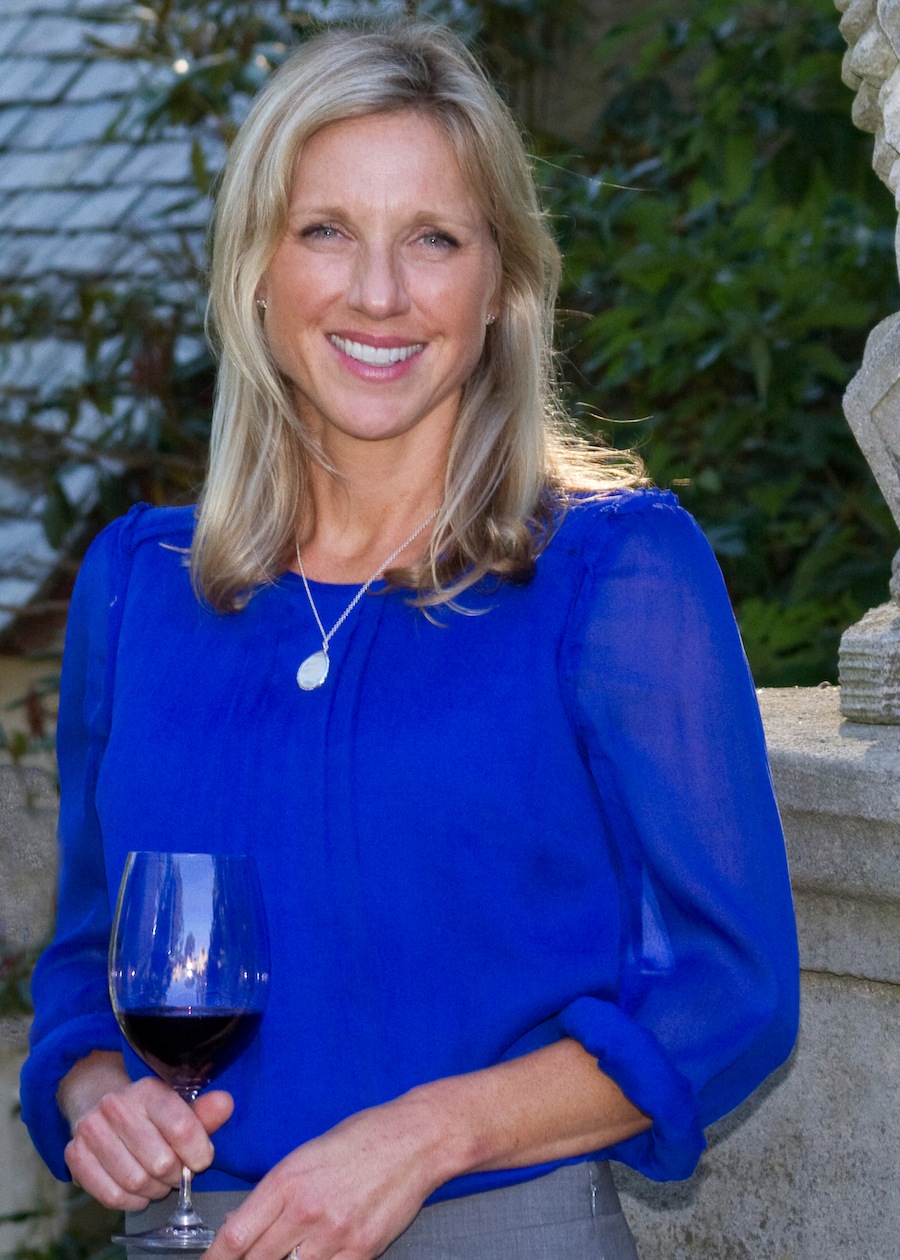 SANGIOVESE
SEPTEMBER
SANGIOVESE
SEPTEMBER
by Cristina Mariani-May
co-CEO of Banfi
Vintners America's leading wine importer
Wine is part of my everyday life,
both as a profession and as a passion. But this
month in particular, one grape varietal has really taken
center stage in my daily activities – that most Italian
of grapes, Sangiovese, and its ultimate expression –
Brunello di Montalcino.
Sangiovese is on my mind more than usual for a number of
reasons. First,
we are approaching the days when the first Sangiovese
grapes will be harvested.
From mid-September through mid-October, the
Sangiovese grown for our various styles of red wines
will be harvested, culminating with the top selection
for Brunello di Montalcino.
Second, cooler weather here means it is time to start
enjoying more red wines and especially Sangiovese based
wines. That
includes our cru of Brunello, Poggio alle Mura,
literally the cream of the crop of our Sangiovese
vineyards. Alongside our Poggio alle Mura Brunello di
Montalcino, this year we introduced two more wines from
the cru Poggio alle Mura – a Rosso di Montalcino and a
Riserva of Brunello.
Rosso is sort of like the younger brother of
Brunello, also made from 100% Sangiovese grapes but
usually a selection from younger vines and the wine is
aged only two years compared to the four required for
Brunello. The
Riserva, on the other hand, is an even more selective
harvest of Sangiovese, and ages for an additional year
before release.
What is so
special about this cru Poggio alle Mura? Well, it is
the result our over 30 years of ongoing research at my
family’s vineyard estate, Castello Banfi. When we first
began planting our vines there in the late 1970s studies
from the University of Bordeaux indicated 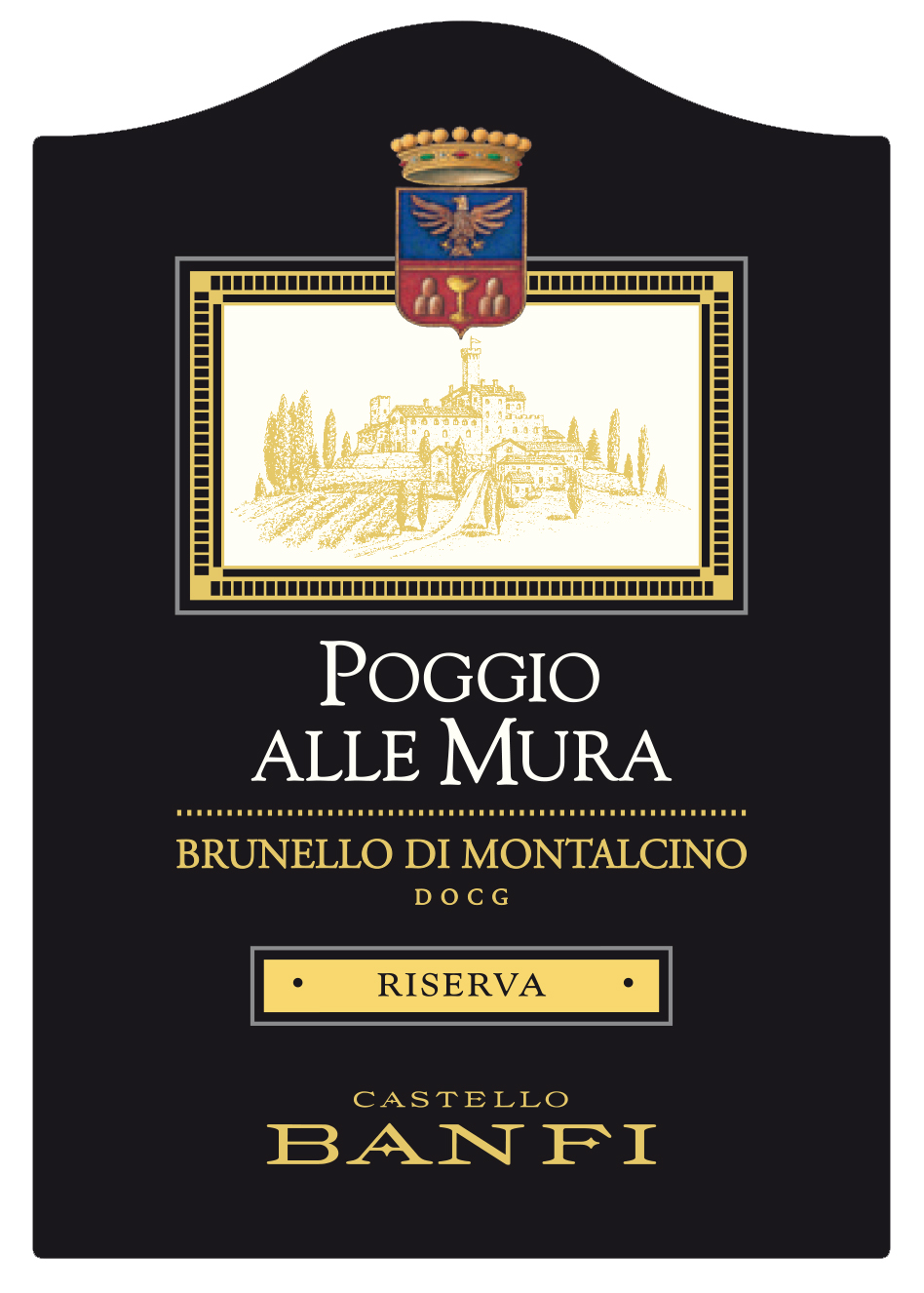 which strains of many varietals we should
plant, based on the soil type and microclimate of each
vineyard. But
when it came to the region’s native Sangiovese, there
was only local lore, no scientific research. So we took it
upon ourselves to figure out this vine, and set off on
three decades of incredibly detailed research.
which strains of many varietals we should
plant, based on the soil type and microclimate of each
vineyard. But
when it came to the region’s native Sangiovese, there
was only local lore, no scientific research. So we took it
upon ourselves to figure out this vine, and set off on
three decades of incredibly detailed research.
We started with 600 apparent variations on Sangiovese,
because it is so susceptible to variations in weather
and soil, and narrowed that down to 160 truly
genetically different clones. We planted a vineyard with two
rows of each type, made wine from each of them, and
charted the differences – remember, you only get one
chance a year to make wine, so this took time.
It took about ten years to get some concrete results,
though we continue to experiment today and always will –
you never stop learning in science and nature! Once we
determined which were the best, complementary clones
that could be planted together to make the best
Brunello, we chose to plant them in what we determined
to be the optimal vineyard sites. Coincidentally,
the best soils and climate conditions are in the slopes
surrounding the medieval fortress today known as
Castello Banfi, known since Etruscan times as Poggio
alle Mura – the walled hilltop. Hence the
name of our most special “cru” of Brunello, representing
a synthesis between tradition and innovation.
Though the focus of this study was
our Brunello, all of our Sangiovese-based wines,
including the super Tuscans SummuS, Cum Laude, and
Centine, benefitted from this work. And that’s
the third reason for celebrating Sangiovese this month,
for the range of wonderful reds that usher us into
autumn! One
wine in particular was inspired by our research – the
BelnerO, a Sangiovese dominant blend with what I like to
call a kiss of Cabernet and a whisper of Merlot. We grow the
grapes a little differently for BelnerO than for
Brunello, make the wine with less oak aging and released
it earlier from the winery, providing a counterpoint to
Brunello and a lovely terroir-driven wine in its own
right.
I am finding that despite all this focus on Sangiovese,
I never grow tired of it.
I earlier referred to Sangiovese as a most
Italian varietal, and that is part of the reason. If you know
Italians, you know that by nature we are multi-faceted,
varying in mood, and always passionate. As a nation,
we span from the hot sunny beaches of Sicily near the
African coast to the rugged mountains and Alpine ski
slopes of Trentino-Alto Adige in the north. Sangiovese is
grown in almost all of Italy’s regions and reflects the
unique nature of each; it is most famous (rightfully so)
in Tuscany, yet even there it reflects the nuances of
each hilltop, valley and subzone. It has
something a little different to say in Brunello than
Chianti, Morellino than Vino Nobile di Montepulciano,
Rosso di Montalcino than Super Tuscan blends.
Here is a
smattering of Sangiovese-based wines that you may wish
to get to know better, reflecting a spectrum that
appeals to every occasion, every taste, and every
budget. I
can assure you that the conversation will never become
boring.
 Recommendations for
Celebrating Sangiovese
Recommendations for
Celebrating Sangiovese
BelnerO
Proprietor’s Reserve
Sangiovese – A
refined cuvée of noble red grapes perfected by
our pioneering clonal research. This dark beauty,
BelnerO, is produced at our innovative winery, chosen 11
consecutive years as Italy’s Premier Vineyard Estate.
Fermented in our patented temperature controlled French
oak and aged approximately 2 additional years.
Unfiltered, and Nitrogen bottled to minimize sulfites.
Castello Banfi Brunello di
Montalcino – Rich, round,
velvety and intensely aromatic, with flavor hints of
licorice, cherry, and spices. Brunello di Montalcino
possesses an intense ruby-red color, and a depth,
complexity and opulence that is softened by an elegant,
lingering aftertaste. Unfiltered after 1998 vintage.
Castello Banfi Rosso di Montalcino – Brunello's "younger brother," produced from select Sangiovese grapes and aged in barrique for 10 to 12 months. Deep ruby-red, elegant, vibrant, well-balanced and stylish with a dry velvety finish.
Poggio all’Oro Brunello di Montalcino Riserva – A single vineyard selection of our most historically outstanding Sangiovese, aged five years before release, the additional year more than that required of Brunello including 6 months in barrel and 6 months more in bottle to grant its “Riserva” designation. Incredible elegance and harmony. Intense with lots of fruit and subtle wood influence. Round, complete, well balanced with hints of chocolate and berries. Unfiltered after 1998.
Poggio alle Mura – The first
tangible result of years of intensive clonal research on
Montalcino’s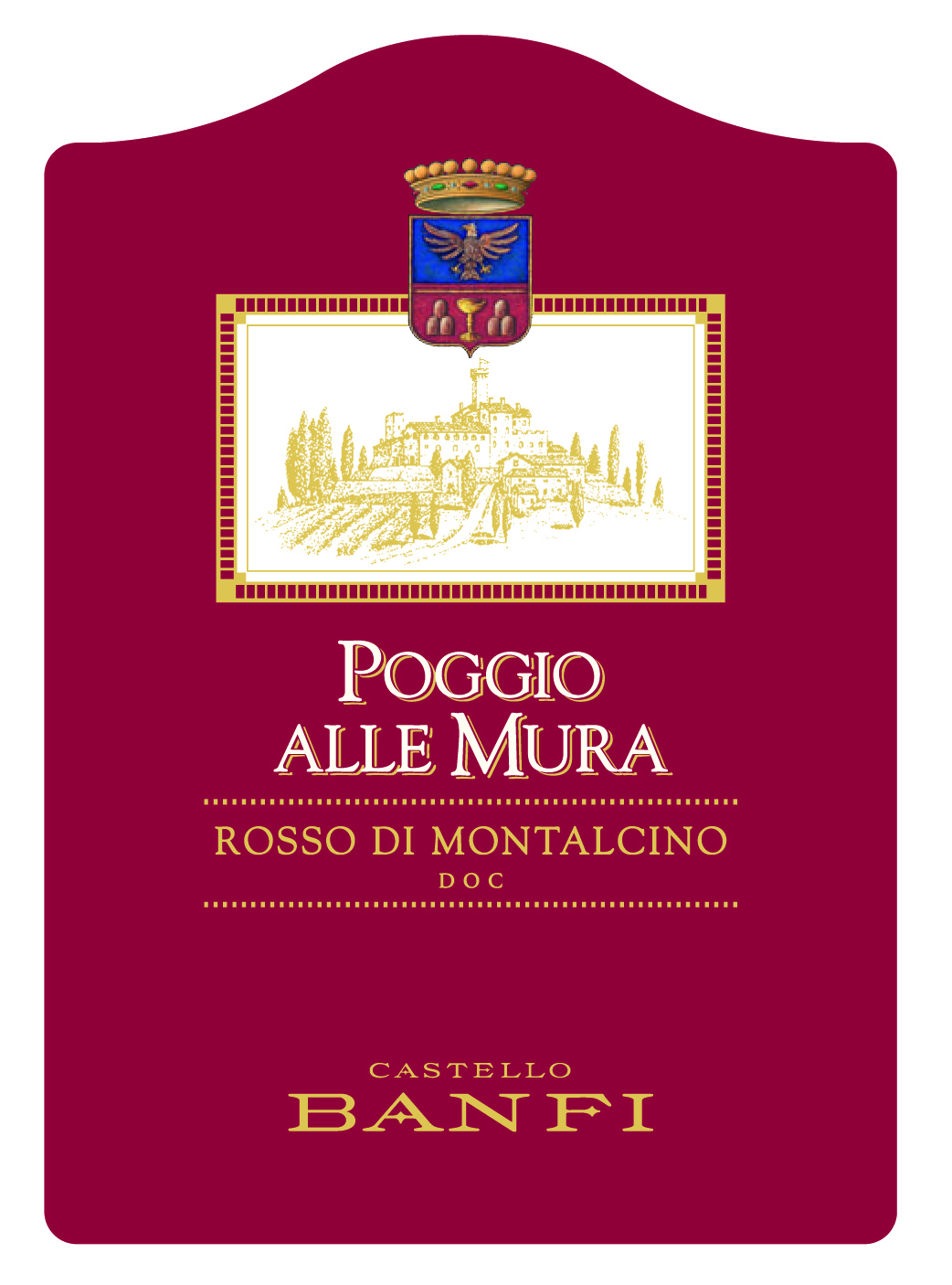 native Sangiovese grape. Estate
bottled from the splendidly sun drenched vineyards
surrounding the medieval Castello from which it takes
its name. The
Brunello di
Montalcino is seductive, silky and smoky. Deep ruby in
color with an expressive bouquet of violets, fruits and
berries as well as cigar box, cedar and exotic spices.
The Rosso di
Montalcino is also intense ruby red. The bouquet
is fresh and fruity with typical varietal notes of
cherry and blackberry, enriched by more complex hints of
licorice, tobacco and hazelnut. It is full
bodied, yet with a soft structure, and a surprisingly
long finish. The Poggio
alle Mura Brunello di Montalcino Riserva is deep
ruby red with garnet reflections and a rich, ample
bouquet that hints of prune jam, coffee, cacao and a
light balsamic note.
It is full and powerful, with ripe and gentle
tannins that make it velvety and harmonious; this wine
is supported by a pleasing minerality that to me speaks
soundly of that special hillside in southern Montalcino.
native Sangiovese grape. Estate
bottled from the splendidly sun drenched vineyards
surrounding the medieval Castello from which it takes
its name. The
Brunello di
Montalcino is seductive, silky and smoky. Deep ruby in
color with an expressive bouquet of violets, fruits and
berries as well as cigar box, cedar and exotic spices.
The Rosso di
Montalcino is also intense ruby red. The bouquet
is fresh and fruity with typical varietal notes of
cherry and blackberry, enriched by more complex hints of
licorice, tobacco and hazelnut. It is full
bodied, yet with a soft structure, and a surprisingly
long finish. The Poggio
alle Mura Brunello di Montalcino Riserva is deep
ruby red with garnet reflections and a rich, ample
bouquet that hints of prune jam, coffee, cacao and a
light balsamic note.
It is full and powerful, with ripe and gentle
tannins that make it velvety and harmonious; this wine
is supported by a pleasing minerality that to me speaks
soundly of that special hillside in southern Montalcino.
SummuS – A wine of towering elegance, SummuS is an extraordinary blend of Sangiovese which contributes body; Cabernet Sauvignon for fruit and structure; and Syrah for elegance, character and a fruity bouquet. An elegant, complex and harmonious red wine.
Cum Laude – A complex and elegant red which graduated “With Honors,” characterized by aromas of juicy berries and fresh spices.
Centine – A Cuvee that is more than half Sangiovese, the balanced consisting of equal parts of Cabernet Sauvignon and Merlot. Vinified in a firm, round style that easily accompanies a wide range of dishes, this is a smooth and fragrantly satisfying wine with international character, and a perennial favorite at my own dinner table.
Banfi Chianti Superiore – The “Superiore” designation signifies stricter government regulations regarding production and aging requirements, as compared to regular Chianti. An intense ruby red wine with fruit forward aromas and floral notes. This is a round wine with well-balanced acidity and fruit.
Banfi Chianti Classico – An enduring classic: alluring bouquet of black fruit and violets; rich flavors of cherry and leather; supple tannins and good acidity for dining.
Banfi Chianti Classico Riserva – Produced from select grapes grown in the "Classico" region of Chianti, this dry, fruity and well-balanced red has a full bouquet reminiscent of violets.
Fonte alla Selva Chianti Classico – This is our newest entry into the Chianti arena, coming from a 99 acre estate in Castellina, the heart of the Chianti Classico region. The wine is a captivating mauve red that smells of cherry, plum and blackberry with hints of spice. It is round, full and balanced with very good acidity.
Col di Sasso – Sangiovese
and Cabernet Sauvignon.
Luscious, complex and soft with persistent notes
of fruit and great Italian style structure.
Any of John Mariani's
books below may be ordered from amazon.com.
 |
The Encyclopedia of American Food and Drink by John F. Mariani (Bloomsbury USA, $35) Modesty forbids me to praise my own new book, but let me proudly say that it is an extensive revision of the 4th edition that appeared more than a decade ago, before locavores, molecular cuisine, modernist cuisine, the Food Network and so much more, now included. Word origins have been completely updated, as have per capita consumption and production stats. Most important, for the first time since publication in the 1980s, the book includes more than 100 biographies of Americans who have changed the way we cook, eat and drink -- from Fannie Farmer and Julia Child to Robert Mondavi and Thomas Keller. "This book is amazing! It has entries for everything from `abalone' to `zwieback,' plus more than 500 recipes for classic American dishes and drinks."--Devra First, The Boston Globe. "Much needed in any kitchen library."--Bon Appetit. |
"Eating Italian will never be the same after reading John Mariani's entertaining and savory gastronomical history of the cuisine of Italy and how it won over appetites worldwide. . . . This book is such a tasteful narrative that it will literally make you hungry for Italian food and arouse your appetite for gastronomical history."--Don Oldenburg, USA Today. "Italian
restaurants--some good, some glitzy--far
outnumber their French rivals. Many of
these establishments are zestfully described
in How Italian Food Conquered the World, an
entertaining and fact-filled chronicle by
food-and-wine correspondent John F.
Mariani."--Aram Bakshian Jr., Wall Street
Journal.
"Equal parts
history, sociology, gastronomy, and just
plain fun, How Italian Food Conquered the
World tells the captivating and delicious
story of the (let's face it) everybody's
favorite cuisine with clarity, verve and
more than one surprise."--Colman Andrews,
editorial director of The Daily
Meal.com. "A fantastic and fascinating
read, covering everything from the influence
of Venice's spice trade to the impact of
Italian immigrants in America and the
evolution of alta cucina. This book will
serve as a terrific resource to anyone
interested in the real story of Italian
food."--Mary Ann Esposito, host of PBS-TV's
Ciao
Italia. "John Mariani has written the
definitive history of how Italians won their
way into our hearts, minds, and
stomachs. It's a story of pleasure over
pomp and taste over technique."--Danny Meyer,
owner of NYC restaurants Union Square
Cafe, The Modern, and Maialino.
|
 |
 |
 |
 |
 |
 |
 |
 |
 Everett Potter's Travel Report:
Everett Potter's Travel Report: 
 Eating Las Vegas
is the new on-line site for Virtual Gourmet
contributor John A. Curtas., who since 1995
has been commenting on the Las Vegas food
scene and reviewing restaurants for Nevada
Public Radio. He is also the
restaurant critic for KLAS TV, Channel 8 in
Las Vegas, and his past reviews can be
accessed at KNPR.org.
Click on the logo below to go directly to
his site.
Eating Las Vegas
is the new on-line site for Virtual Gourmet
contributor John A. Curtas., who since 1995
has been commenting on the Las Vegas food
scene and reviewing restaurants for Nevada
Public Radio. He is also the
restaurant critic for KLAS TV, Channel 8 in
Las Vegas, and his past reviews can be
accessed at KNPR.org.
Click on the logo below to go directly to
his site.

Tennis Resorts Online: A Critical Guide to the World's Best Tennis Resorts and Tennis Camps, published by ROGER COX, who has spent more than two decades writing about tennis travel, including a 17-year stretch for Tennis magazine. He has also written for Arthur Frommer's Budget Travel, New York Magazine, Travel & Leisure, Esquire, Money, USTA Magazine, Men's Journal, and The Robb Report. He has authored two books-The World's Best Tennis Vacations (Stephen Greene Press/Viking Penguin, 1990) and The Best Places to Stay in the Rockies (Houghton Mifflin, 1992 & 1994), and the Melbourne (Australia) chapter to the Wall Street Journal Business Guide to Cities of the Pacific Rim (Fodor's Travel Guides, 1991).


MARIANI'S VIRTUAL GOURMET
NEWSLETTER is published weekly. Editor/Publisher: John
Mariani.
Editor: Walter Bagley. Contributing Writers: Christopher Mariani,
Robert Mariani, Misha
Mariani,
John A. Curtas, Edward Brivio, Mort Hochstein,
Andrew Chalk, Dotty Griffith and Brian Freedman. Contributing
Photographers: Galina Dargery, Bobby
Pirillo. Technical Advisor: Gerry McLoughlin.
To un-subscribe from this newsletter,click here.
© copyright John Mariani 2014
